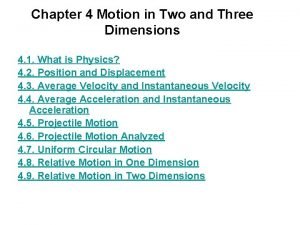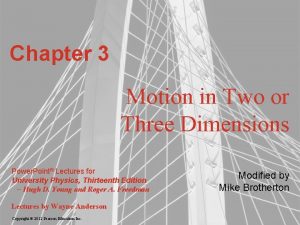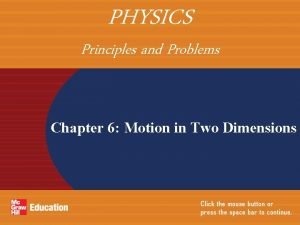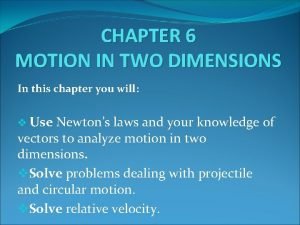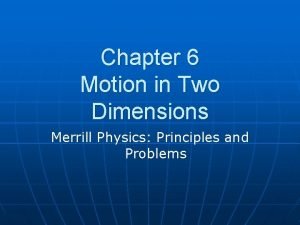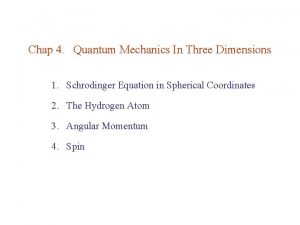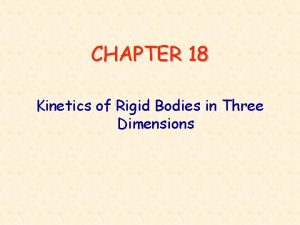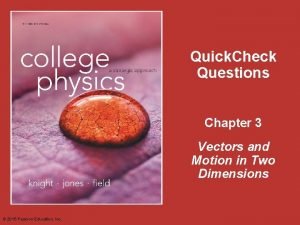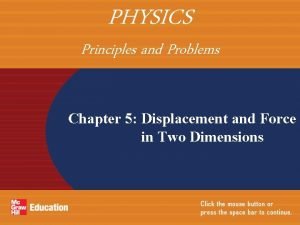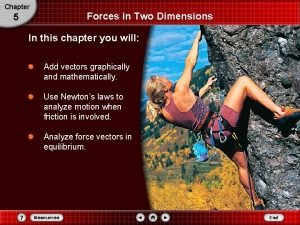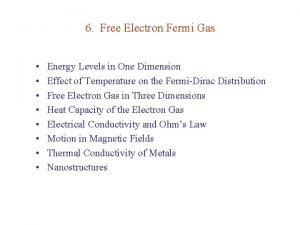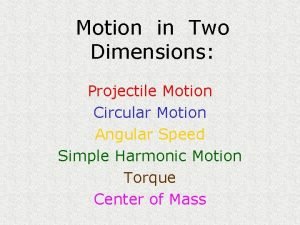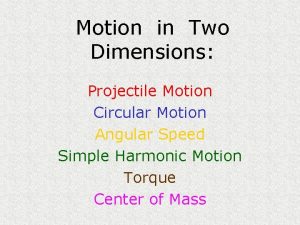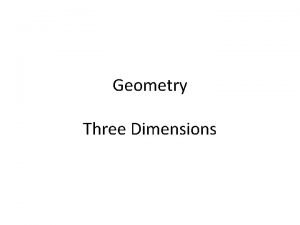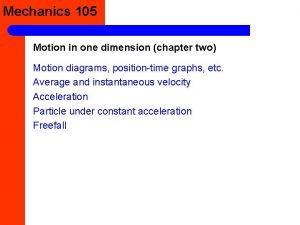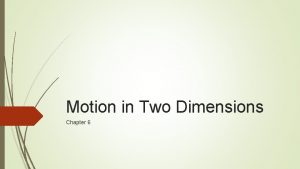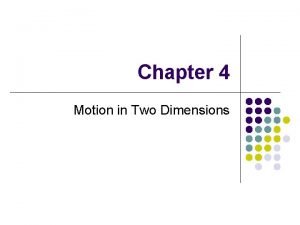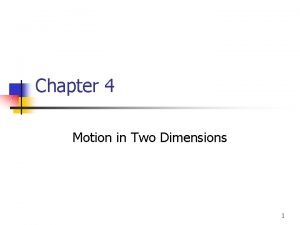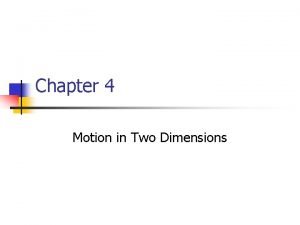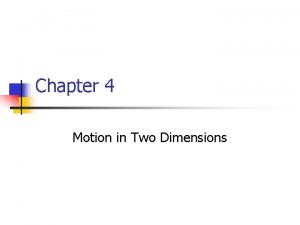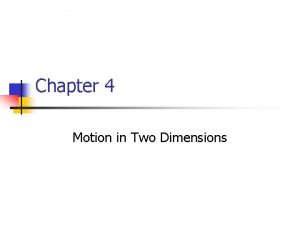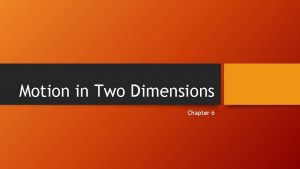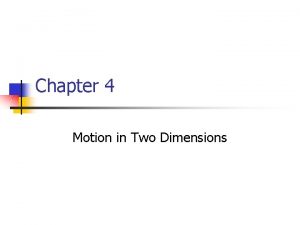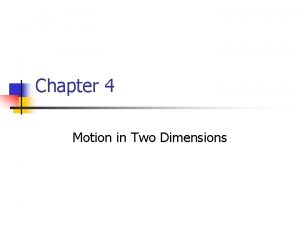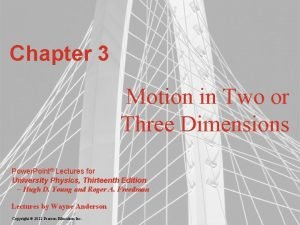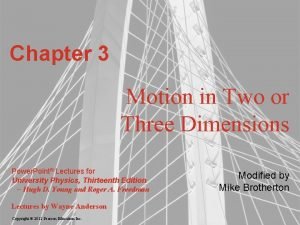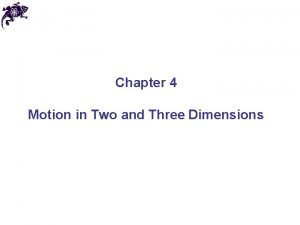Mechanics 105 Motion in two dimensions chapter three




















- Slides: 20

Mechanics 105 Motion in two dimensions (chapter three) Kinematic quantities as vectors Two dimensional motion with constant acceleration Projectile motion Uniform circular motion Tangential and radial acceleration Relative velocity

Mechanics 105 Position, velocity and acceleration vectors Position: r(t) (bold indicates vector) Velocity: v(t) Acceleration: a(t)

Mechanics 105 Position, velocity and acceleration vectors Exact same equations of kinematics can be used – now as vector equations E. g. for a particle under constant acceleration: (note “missing” equation – division of vectors not yet discussed

Mechanics 105 Position, velocity and acceleration vectors What’s the point? l l We won’t use the actual vector nature of these quantities much at first. Realize that the entire motion can be described with vectors (simplified notation) Motion is coupled through time variable Circular motion – changes in both magnitude and direction

Mechanics 105 2 d motion with constant acceleration Equivalent to two sets of independent motion – the parameter connecting them is time

Mechanics 105 Projectile motion General assumptions - no air resistance - g is constant Initial velocity has components along x and y directions Acceleration has only y component = -g

Mechanics 105 Projectile motion This yields: The motion in the x and y directions are independent! Demos

Mechanics 105 Projectile motion l If we want a picture of the total motion of the object over time, we can solve the first equation for t and substitute it in the second l Valid for all xf, yf (dropped f subscript) Equation of a parabola Motion uniquely defined by vi and i Note – use of tan only good for 0< i< /2 l l l

Mechanics 105 Parabolic trajectory

Mechanics 105 Projectile motion – range equation(s)

Mechanics 105 Parabolic trajectory Example: Derive the range equations in terms of the x and y components of the initial velocity Peak time Height Range

Mechanics 105 Uniform circular motion Direction of velocity changes objects still accelerate vector nature of acceleration non constant acceleration – the change in x and y components of velocity is not constant

Mechanics 105 Uniform circular motion centripetal acceleration – constant acceleration along the direction towards the center of the circle Period of revolution

Mechanics 105 Radial and tangential acceleration Velocity vector always tangent to path – acceleration in direction of motion is called tangential acceleration The change in direction of the velocity is the component of acceleration along the direction of the instantaneous radius of curvature, called the radial acceleration

Mechanics 105 Radial and tangential acceleration The total acceleration at any point of a curved path is the vector sum of the two. Note that the directions of the axes (radial and tangential) change as the object moves. Example: What are the radial and tangential accelerations of an object undergoing projectile motion?

Mechanics 105 Relative velocity r. PO is the position of P measured in the O frame r. PO’ is the position of P measured in the O’ frame v. O’O is the velocity of the O’ frame measured in the O frame Think about the motion – does the result make sense?

Mechanics 105 Relative velocity - examples 1. A boat’s speed in still water is 4. 00 m/s. If the pilot wants to travel directly across a river flowing at 3. 00 m/s, at what angle does he need to steer the boat? 2. If the same boat instead heads directly across the river, where will the boat end up if the river is 100. m wide? 3. Two cars approach an intersection at right angles and with the same speed (20. 0 m/s). What is the relative velocity of one car with respect to the other?

Mechanics 105 Learning curve

Mechanics 105 YOU MIGHT BE A PHYSICS MAJOR. . . l l l if you have no life - and you can PROVE it mathematically. if you enjoy pain. if you know vector calculus but you can't remember how to do long division. if you chuckle whenever anyone says 'centrifugal force. ' if you've actually used every single function on your graphing calculator. if it is sunny and 70 degrees outside, and you are working on a computer. if you laugh at jokes about mathematicians. if you consider ANY non-science course 'easy. ' if you'll assume that a 'horse' is a 'sphere' in order to make the math easier. if you understood more than five of these indicators. if you make a hard copy of this list, and post it on your door. from /www. physlink. com

Mechanics 105 Summary (chapter two and three) Kinematics – “how” of motion Position, velocity and acceleration – vector nature, time derivatives Average quantities – only depend on beginning and end points Kinematic equations – constant acceleration In two and three dimensions – motion along different axes is independent Free fall, projectile motion Motion along curved path – tangential and radial acceleration Relative motion Be careful about sig. figures, units
 Motion in two and three dimensions
Motion in two and three dimensions Motion in two or three dimensions
Motion in two or three dimensions Chapter 6 assessment physics
Chapter 6 assessment physics Chapter 6 study guide motion in two dimensions
Chapter 6 study guide motion in two dimensions Chapter 6 motion in two dimensions
Chapter 6 motion in two dimensions Chapter 6 motion in two dimensions
Chapter 6 motion in two dimensions Quantum mechanics in three dimensions
Quantum mechanics in three dimensions Motion of rigid body in three dimensions
Motion of rigid body in three dimensions Vectors quick check
Vectors quick check A cart slows down while moving away from the origin
A cart slows down while moving away from the origin 5 displacement and force in two dimensions
5 displacement and force in two dimensions Forces in 2 dimensions worksheet answers
Forces in 2 dimensions worksheet answers Chapter 2 section 1 describing motion answer key
Chapter 2 section 1 describing motion answer key The main difference between speed and velocity involves
The main difference between speed and velocity involves Section 1 describing motion
Section 1 describing motion Euler equation
Euler equation Corporate scope
Corporate scope Dimensions of corporate strategy
Dimensions of corporate strategy Free electron gas
Free electron gas Dimensions of justice
Dimensions of justice Three dimensions of critical thinking
Three dimensions of critical thinking
